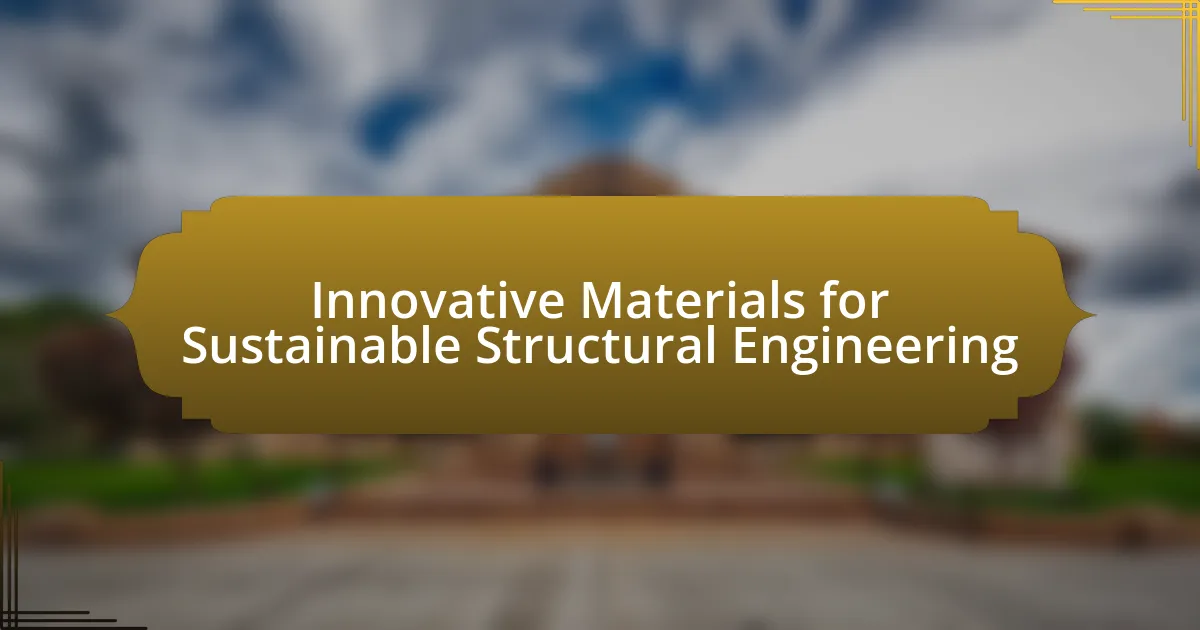Innovative materials for sustainable structural engineering encompass a range of eco-friendly options, including bio-based composites, recycled aggregates, and self-healing concrete. These materials significantly contribute to sustainability by reducing environmental impact, enhancing resource efficiency, and promoting energy conservation in construction practices. Key properties such as high strength-to-weight ratios and durability make them suitable for structural applications, while their adoption can lead to long-term economic benefits and improved health and safety for construction workers. The article also addresses the challenges associated with these materials, including cost, availability, and regulatory hurdles, and emphasizes the importance of education, collaboration, and best practices in facilitating their integration into the construction industry.

What are Innovative Materials for Sustainable Structural Engineering?
Innovative materials for sustainable structural engineering include bio-based composites, recycled aggregates, and self-healing concrete. Bio-based composites, such as those made from natural fibers and resins, reduce reliance on fossil fuels and lower carbon footprints. Recycled aggregates, derived from construction waste, minimize resource extraction and landfill use, promoting circular economy principles. Self-healing concrete incorporates bacteria or polymers that can repair cracks autonomously, extending the lifespan of structures and reducing maintenance costs. These materials contribute to sustainability by enhancing resource efficiency and reducing environmental impact in construction practices.
How do these materials contribute to sustainability in construction?
Innovative materials contribute to sustainability in construction by reducing environmental impact, enhancing energy efficiency, and promoting resource conservation. For instance, materials such as recycled steel and bamboo have lower carbon footprints compared to traditional materials like concrete and virgin timber. According to a study published in the Journal of Cleaner Production, using recycled steel can reduce greenhouse gas emissions by up to 75% compared to new steel production. Additionally, materials like cross-laminated timber sequester carbon, further mitigating climate change effects. These advancements not only minimize waste but also encourage the use of renewable resources, aligning construction practices with sustainable development goals.
What properties make these materials suitable for structural applications?
Innovative materials for structural applications are suitable due to their high strength-to-weight ratio, durability, and sustainability. These properties enable structures to support significant loads while minimizing material usage, which is crucial for reducing environmental impact. For instance, materials like carbon fiber composites exhibit exceptional tensile strength and low density, making them ideal for applications where weight reduction is essential without compromising structural integrity. Additionally, sustainable materials such as bamboo and recycled steel offer both strength and environmental benefits, as they can be sourced responsibly and contribute to lower carbon footprints in construction.
How do innovative materials reduce environmental impact?
Innovative materials reduce environmental impact by utilizing sustainable resources and enhancing energy efficiency in construction. For instance, materials like recycled steel and bamboo require less energy to produce compared to traditional materials, significantly lowering carbon emissions. Additionally, innovations such as self-healing concrete can extend the lifespan of structures, reducing the need for repairs and new materials over time. Research indicates that using recycled materials can decrease energy consumption by up to 90%, demonstrating a clear environmental benefit.
What types of innovative materials are currently being used?
Innovative materials currently being used in sustainable structural engineering include carbon fiber reinforced polymers (CFRP), self-healing concrete, and bio-based composites. CFRP is utilized for its high strength-to-weight ratio and corrosion resistance, making it ideal for reinforcing structures while reducing overall weight. Self-healing concrete incorporates microcapsules that release healing agents when cracks form, enhancing durability and lifespan. Bio-based composites, derived from natural fibers and resins, offer an eco-friendly alternative to traditional materials, reducing carbon footprint and promoting sustainability. These materials are increasingly adopted in construction projects to improve performance and environmental impact.
What are bio-based materials and how are they utilized?
Bio-based materials are materials derived from renewable biological resources, such as plants, animals, and microorganisms. These materials are utilized in various applications, including construction, packaging, and textiles, to reduce reliance on fossil fuels and minimize environmental impact. For instance, bio-based polymers like polylactic acid (PLA) are used in 3D printing and biodegradable packaging, while natural fibers such as hemp and bamboo are employed in sustainable building materials. The use of bio-based materials contributes to sustainability by lowering carbon emissions and promoting resource efficiency, as evidenced by studies showing that bio-based composites can significantly reduce the carbon footprint of construction projects compared to traditional materials.
How do recycled materials play a role in sustainable engineering?
Recycled materials significantly contribute to sustainable engineering by reducing waste and conserving natural resources. The incorporation of materials such as recycled concrete, metals, and plastics minimizes the demand for virgin resources, thereby lowering the environmental impact associated with extraction and processing. For instance, using recycled concrete aggregates can reduce the need for new gravel, which is a finite resource, and studies show that this practice can decrease carbon emissions by up to 30% compared to traditional concrete production. Additionally, utilizing recycled materials often requires less energy, further enhancing sustainability in engineering practices.
Why is the adoption of innovative materials important for the future of construction?
The adoption of innovative materials is crucial for the future of construction because it enhances sustainability, efficiency, and performance in building practices. Innovative materials, such as self-healing concrete and recycled composites, reduce environmental impact by minimizing waste and energy consumption during production. For instance, the use of recycled materials can decrease carbon emissions by up to 30%, as reported by the World Green Building Council. Furthermore, these materials often provide improved durability and resilience, leading to longer-lasting structures that require less maintenance. This shift towards innovative materials aligns with global sustainability goals, making it essential for the construction industry’s future.
What challenges do traditional materials present in terms of sustainability?
Traditional materials, such as concrete, steel, and wood, present significant challenges in terms of sustainability due to their high carbon emissions, resource depletion, and environmental impact. For instance, the production of cement, a key ingredient in concrete, accounts for approximately 8% of global carbon dioxide emissions, highlighting its substantial contribution to climate change. Additionally, the extraction of raw materials for steel and concrete often leads to habitat destruction and biodiversity loss. Furthermore, traditional materials can be energy-intensive to produce and transport, exacerbating their environmental footprint. These factors collectively hinder the progress toward sustainable construction practices.
How can innovative materials enhance the resilience of structures?
Innovative materials enhance the resilience of structures by providing superior strength, flexibility, and durability compared to traditional materials. For instance, materials such as fiber-reinforced polymers and self-healing concrete can absorb and dissipate energy during events like earthquakes, reducing damage. Research indicates that structures utilizing these materials can withstand extreme weather conditions and impacts better, leading to longer lifespans and lower maintenance costs. A study by the National Institute of Standards and Technology found that buildings constructed with advanced composites exhibited a 30% increase in resilience against seismic forces compared to conventional materials.
How can the construction industry transition to using innovative materials?
The construction industry can transition to using innovative materials by adopting a systematic approach that includes research and development, collaboration with material scientists, and investment in training for construction professionals. This transition is supported by the increasing availability of advanced materials such as self-healing concrete, recycled plastics, and bio-based composites, which have been shown to enhance sustainability and performance. For instance, a study by the National Institute of Standards and Technology highlights that using recycled materials can reduce carbon emissions by up to 30% compared to traditional materials. By integrating these innovative materials into building practices, the construction industry can improve efficiency, reduce environmental impact, and meet regulatory standards for sustainability.
What are the key factors influencing the adoption of these materials?
The key factors influencing the adoption of innovative materials for sustainable structural engineering include cost-effectiveness, performance characteristics, regulatory compliance, and environmental impact. Cost-effectiveness is crucial as projects must remain within budget while utilizing advanced materials. Performance characteristics, such as durability and strength, determine the suitability of materials for specific applications. Regulatory compliance ensures that materials meet safety and environmental standards, which is essential for gaining approval in construction projects. Lastly, the environmental impact of materials, including their carbon footprint and recyclability, plays a significant role in the decision-making process, as stakeholders increasingly prioritize sustainability in engineering practices.

What are the benefits of using Innovative Materials in Structural Engineering?
The benefits of using innovative materials in structural engineering include enhanced durability, reduced weight, and improved sustainability. Innovative materials, such as high-performance concrete and fiber-reinforced polymers, offer superior resistance to environmental factors, which extends the lifespan of structures. For instance, high-performance concrete can withstand harsh weather conditions and chemical exposure, reducing maintenance costs over time. Additionally, lightweight materials contribute to lower transportation and construction costs, as they require less energy to handle and install. Furthermore, many innovative materials are designed with sustainability in mind, utilizing recycled components or reducing carbon footprints during production. Research indicates that the use of such materials can lead to a significant decrease in overall resource consumption and environmental impact, aligning with modern engineering goals for sustainability.
How do these materials improve energy efficiency in buildings?
Innovative materials improve energy efficiency in buildings by enhancing insulation, reducing thermal bridging, and optimizing energy consumption. For instance, materials like aerogels and phase change materials provide superior thermal resistance, which minimizes heat loss in winter and heat gain in summer. Studies show that buildings utilizing advanced insulation materials can achieve energy savings of up to 30% compared to traditional materials. Additionally, smart materials that respond to environmental changes can adjust their properties to maintain optimal indoor conditions, further reducing reliance on heating and cooling systems.
What role do innovative materials play in reducing operational costs?
Innovative materials significantly reduce operational costs by enhancing efficiency and durability in construction and engineering applications. These materials, such as high-performance concrete and advanced composites, often require less maintenance and have longer lifespans compared to traditional materials. For instance, the use of fiber-reinforced polymers can lead to a reduction in structural weight, which decreases the overall energy consumption during transportation and installation. Additionally, studies have shown that buildings constructed with innovative materials can achieve energy savings of up to 30% over their lifecycle, further lowering operational costs.
How can they enhance the overall performance of structures?
Innovative materials enhance the overall performance of structures by improving strength, durability, and sustainability. For instance, the use of high-performance concrete can increase load-bearing capacity while reducing maintenance costs, as evidenced by studies showing that structures utilizing this material can last up to 50% longer than those built with traditional concrete. Additionally, materials like fiber-reinforced polymers provide superior resistance to environmental degradation, which is crucial for extending the lifespan of structures in harsh conditions. These advancements not only optimize structural integrity but also contribute to energy efficiency and reduced carbon footprints in construction practices.
What are the economic advantages of using innovative materials?
The economic advantages of using innovative materials include reduced construction costs, enhanced durability, and improved energy efficiency. Innovative materials, such as high-performance concrete and advanced composites, can lower labor and material expenses by streamlining construction processes and minimizing maintenance needs. For instance, the use of self-healing concrete can extend the lifespan of structures, reducing the frequency and cost of repairs. Additionally, materials that improve energy efficiency, like insulated panels, can lead to significant savings on energy bills over time. According to a study by the National Institute of Standards and Technology, innovative materials can reduce lifecycle costs by up to 30%, demonstrating their economic viability in sustainable structural engineering.
How do these materials affect project timelines and budgets?
Innovative materials for sustainable structural engineering can significantly impact project timelines and budgets by enhancing efficiency and reducing costs. For instance, materials like high-performance concrete and recycled steel can expedite construction processes due to their superior strength and durability, which often leads to shorter project durations. Additionally, the use of sustainable materials can lower overall expenses by minimizing waste and reducing the need for frequent repairs or replacements, as evidenced by studies showing that projects utilizing these materials can achieve up to 30% cost savings over their lifecycle.
What long-term savings can be expected from their use?
The use of innovative materials in sustainable structural engineering can lead to significant long-term savings, estimated to be between 20% to 30% in overall project costs. These savings arise from reduced material consumption, lower maintenance costs, and enhanced energy efficiency. For instance, materials such as high-performance concrete and recycled steel not only decrease the volume of resources needed but also extend the lifespan of structures, thereby minimizing the frequency and cost of repairs. Additionally, the integration of sustainable materials often results in lower energy consumption during both construction and operation phases, contributing to substantial cost reductions over time.
How do innovative materials impact the health and safety of construction workers?
Innovative materials significantly enhance the health and safety of construction workers by reducing hazards and improving working conditions. For instance, materials like self-healing concrete and lightweight composites minimize the risk of structural failures and injuries associated with heavy lifting. Additionally, the use of non-toxic, low-VOC (volatile organic compounds) materials decreases exposure to harmful chemicals, promoting better air quality on job sites. Research indicates that the implementation of advanced materials can lead to a 30% reduction in workplace accidents, as reported in the study “Impact of Innovative Materials on Construction Safety” by the National Institute for Occupational Safety and Health. This evidence underscores the positive correlation between innovative materials and improved health and safety outcomes for construction workers.
What safety benefits do these materials provide during construction?
Innovative materials for sustainable structural engineering provide enhanced safety benefits during construction by improving structural integrity and reducing risks associated with traditional materials. For instance, materials like high-performance concrete and fiber-reinforced polymers exhibit superior strength-to-weight ratios, which minimize the likelihood of structural failures. Additionally, these materials often have better resistance to environmental factors such as corrosion and fire, which further enhances safety on construction sites. Research indicates that the use of advanced composites can lead to a 30% reduction in weight while maintaining or exceeding the load-bearing capacity of conventional materials, thereby decreasing the risk of accidents related to heavy lifting and structural collapse.
How do they contribute to healthier indoor environments?
Innovative materials for sustainable structural engineering contribute to healthier indoor environments by improving air quality and reducing harmful emissions. These materials often include low-VOC (volatile organic compounds) options, which minimize the release of toxic substances into the air, thus promoting better respiratory health. For instance, studies have shown that using materials like bamboo and recycled steel can significantly lower indoor pollutants compared to traditional materials. Additionally, these innovative materials often enhance thermal insulation, leading to reduced energy consumption and improved comfort levels, which further supports a healthier indoor atmosphere.

What are the challenges associated with Innovative Materials in Structural Engineering?
The challenges associated with innovative materials in structural engineering include high costs, limited availability, and regulatory hurdles. High costs arise from the research and development required to create and implement these materials, which can deter widespread adoption. Limited availability often stems from the nascent stage of production and supply chains, making it difficult for engineers to source these materials consistently. Regulatory hurdles can complicate the approval process for new materials, as existing codes and standards may not accommodate innovative solutions, leading to delays in project timelines. These challenges collectively hinder the integration of innovative materials into mainstream structural engineering practices.
What barriers exist in the widespread adoption of these materials?
Barriers to the widespread adoption of innovative materials for sustainable structural engineering include high initial costs, limited awareness and understanding among stakeholders, and regulatory challenges. High initial costs can deter investment, as many innovative materials require significant upfront capital compared to traditional options. Limited awareness and understanding hinder acceptance, as stakeholders may lack knowledge about the benefits and applications of these materials. Regulatory challenges arise from existing building codes and standards that may not accommodate new materials, creating obstacles for their integration into mainstream construction practices.
How do regulatory frameworks affect the use of innovative materials?
Regulatory frameworks significantly influence the use of innovative materials by establishing safety, performance, and environmental standards that must be met for materials to be approved for use in construction. These frameworks can either facilitate or hinder innovation; for instance, stringent regulations may delay the adoption of new materials due to lengthy approval processes, while supportive regulations can encourage research and development by providing clear guidelines and incentives. An example is the European Union’s Construction Products Regulation, which sets out harmonized standards for construction materials, thereby promoting the use of innovative materials that meet sustainability criteria.
What are the common misconceptions about these materials?
Common misconceptions about innovative materials for sustainable structural engineering include the belief that they are always more expensive than traditional materials, that they lack durability, and that they are not widely available. In reality, while some innovative materials may have higher initial costs, they often lead to long-term savings through reduced maintenance and energy efficiency. Additionally, many of these materials, such as recycled concrete and engineered wood, have been proven to be highly durable, often exceeding the lifespan of conventional materials. Furthermore, advancements in technology and increased demand have made these materials more accessible in the market, countering the notion of limited availability.
How can these challenges be overcome?
Innovative materials for sustainable structural engineering challenges can be overcome by implementing advanced research and development in material science, promoting collaboration between academia and industry, and adopting regulatory frameworks that encourage sustainable practices. For instance, the development of bio-based composites and recycled materials has shown significant potential in reducing environmental impact while maintaining structural integrity. Research published in the Journal of Cleaner Production highlights that using recycled aggregates in concrete can reduce carbon emissions by up to 30%. Additionally, fostering partnerships between universities and construction firms can lead to the practical application of innovative materials, ensuring that new solutions are effectively integrated into existing construction practices.
What role does education and training play in promoting innovative materials?
Education and training are crucial in promoting innovative materials by equipping individuals with the knowledge and skills necessary to develop and implement new technologies. Through specialized programs, professionals learn about the properties, applications, and sustainability of innovative materials, which fosters creativity and problem-solving in structural engineering. For instance, research conducted by the National Institute of Standards and Technology highlights that educational initiatives in materials science significantly enhance innovation rates in construction practices. This evidence underscores the importance of a well-trained workforce in advancing the use of innovative materials for sustainable structural engineering.
How can collaboration between stakeholders facilitate adoption?
Collaboration between stakeholders can facilitate adoption by creating a unified approach that aligns interests, resources, and expertise. When stakeholders, such as engineers, architects, material suppliers, and regulatory bodies, work together, they can share knowledge and best practices, leading to more effective implementation of innovative materials. For instance, a study by the National Institute of Standards and Technology found that collaborative efforts in construction projects resulted in a 20% increase in efficiency and a 15% reduction in costs, demonstrating that stakeholder collaboration can significantly enhance the adoption of new technologies and materials in sustainable structural engineering.
What best practices should be followed when implementing innovative materials?
When implementing innovative materials in sustainable structural engineering, best practices include thorough material selection, comprehensive testing, and lifecycle assessment. Material selection should prioritize sustainability, performance, and compatibility with existing structures, ensuring that the chosen materials meet environmental standards and project requirements. Comprehensive testing is essential to evaluate the mechanical properties, durability, and environmental impact of the materials under various conditions, which helps in identifying potential issues before full-scale application. Lifecycle assessment provides insights into the long-term effects of the materials on the environment, including resource consumption and waste generation, thereby guiding decision-making towards more sustainable practices. These practices are supported by research indicating that proper material evaluation and testing can significantly enhance the performance and sustainability of structural projects.
How can project managers ensure successful integration of these materials?
Project managers can ensure successful integration of innovative materials for sustainable structural engineering by implementing a structured approach that includes thorough planning, stakeholder engagement, and continuous monitoring. Effective planning involves assessing the compatibility of new materials with existing systems and establishing clear objectives for their use. Engaging stakeholders, including engineers, architects, and contractors, fosters collaboration and ensures that all parties understand the benefits and challenges associated with the materials. Continuous monitoring during the implementation phase allows for real-time adjustments and ensures that the integration aligns with project goals. Research indicates that projects utilizing structured integration processes experience a 30% increase in efficiency and a 25% reduction in material waste, demonstrating the effectiveness of these strategies in achieving successful outcomes.
What are the key considerations for material selection in sustainable projects?
Key considerations for material selection in sustainable projects include environmental impact, resource availability, durability, and lifecycle assessment. Environmental impact focuses on minimizing carbon footprint and pollution during production and disposal. Resource availability ensures that materials are sourced sustainably, avoiding depletion of natural resources. Durability emphasizes the longevity of materials, reducing the need for replacements and maintenance. Lifecycle assessment evaluates the environmental effects of materials from extraction to disposal, guiding choices that support sustainability goals. These considerations are essential for achieving effective and responsible sustainable engineering practices.

Leave a Reply